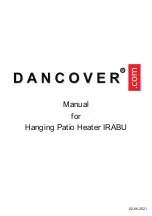
should be used. In order to prevent the
build up of scale and corrosion a
suitable inhibitor should be used. The
system must be correctly vented as
shown in Figs. 5 and 6. The height
differential between the header tank
and the appliance must not exceed
15.2 metres (50 feet).
If all four boiler tappings are used
then, if possible, diagonal pairs should
be connected for domestic hot water
and central heating. Where a common
return is used an injector tee must be
incorporated into the system as shown
in Fig. 7. This will ensure that a good
domestic hot water supply is
maintained when the central heating
pump is operating.
The system must incorporate a gravity
circuit which will normally heat the
domestic hot water and an unvalved
radiator with an output of at least 1
kW. When the appliance is not
connected to a domestic hot water
system the unvalved radiator(s) on the
gravity circuit must have an output of
at least 1.25 kW. This is to prevent
boiling in case of pump failure. All
pipework in the primary circuit must
be 28 mm diameter and the gravity
flow pipe must rise continuously from
the boiler to the open vent. Two
typical systems are shown in Figures
5. and 6.
If the appliance is used to heat a small
central heating system then the heat
output to the room from the fire will
be reduced. Fig. 4. shows the ratio of
space heating to water heating which
can be expected.
Fitting a radiator in the same room as
the fire is recommended as it will
allow greater flexibility in the way
that the system is operated as well as
ensuring that there is sufficient heat.
Connect the heating system to the
boiler ensuring that the primary flow
pipe rises continuously from the
appliance to the vent. Fill the system
with water and check for leaks.
The circulating pump may be
controlled by means of time switches,
room thermostats or outdoor
thermostats. Radiators may be either
manually or thermostatically
controlled. These controls will all
work in conjunction with the
thermostat on the appliance and the
low limit pipe thermostat.
We recommend fitting a pipe
thermostat onto the gravity return to
SYSTEM CONTROLS
Page 6
Country 14B 09/03
Central Heating Flow
Central Heating Return
Drain Cock at Lowest Point
Drain Cock
Indirect Hot Water Cylinder
Cold Water Tank
Overflow
Feed and Expansion Tank
22mm Open Vents
Gravity Radiator
Circulating Pump
Central Heating Return
Drain Cock at Lowest Point
Drain Cock
Indirect Hot Water Cylinder
Domestic Hot Water Draw Off
Cold Water Tank
Overflow
Overflow
Feed and Expansion Tank
22mm Open Vents
Gravity Radiator
Circulating Pump
Injector Tee
Minimum Return Thermostat
Gravity Return
(28mm Pipe)
Central Heating Return
Common Return to Boiler
Central Heating Flow
Minimum Return
Thermostat
(28mm Pipe)
Overflow
Domestic Hot Water Draw Off
Fig. 7. Injector Tee.
Using 4 Boiler Tappings
Using 3 Tappings
Fig. 5. Typical Central Heating & Hot Water System
Fig. 6. Typical Central Heating & Hot Water System





























